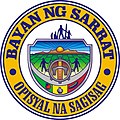Sarrat | |
|---|---|
 New Sarrat Municipal Hall | |
 Map of Ilocos Norte with Sarrat highlighted | |
Location within the Philippines | |
| Coordinates: 18°09′28″N120°38′41″E / 18.1578°N 120.6447°E | |
| Country | Philippines |
| Region | Ilocos Region |
| Province | Ilocos Norte |
| District | 1st district |
| Founded | 1586 |
| Barangays | 24 (see Barangays) |
| Government | |
| • Type | Sangguniang Bayan |
| • Mayor | Ralph Conrad Francia Medrano |
| • Vice Mayor | Virgilio L. Agoto |
| • Representative | Sandro Marcos |
| • Municipal Council | Members |
| • Electorate | 18,042 voters (2025) |
| Area | |
• Total | 57.39 km2 (22.16 sq mi) |
| Elevation | 49 m (161 ft) |
| Highest elevation | 309 m (1,014 ft) |
| Lowest elevation | 5 m (16 ft) |
| Population (2024 census) [3] | |
• Total | 26,294 |
| • Density | 458.2/km2 (1,187/sq mi) |
| • Households | 6,442 |
| Economy | |
| • Income class | 4th municipal income class |
| • Poverty incidence | 5.51 |
| • Revenue | ₱ 209.8 million (2022) |
| • Assets | ₱ 677.3 million (2022) |
| • Expenditure | ₱ 122.6 million (2022) |
| • Liabilities | ₱ 55.96 million (2022) |
| Service provider | |
| • Electricity | Ilocos Norte Electric Cooperative (INEC) |
| Time zone | UTC+8 (PST) |
| ZIP code | 2914 |
| PSGC | |
| IDD : area code | +63 (0)77 |
| Native languages | Ilocano Tagalog |
Sarrat, officially the Municipality of Sarrat (Ilocano : Ili ti Sarrat; Filipino : Bayan ng Sarrat), is a municipality in the province of Ilocos Norte, Philippines. According to the 2024 census, it has a population of 26,294 people. [5]
Contents
- Etymology
- History
- Geography
- Barangays
- Climate
- Demographics
- Economy
- Tourism
- Santa Monica Parish Church
- Santa Monica Parish Museum
- Culture
- Government
- Local government
- Elected officials
- Transportation
- Education
- Primary and elementary schools
- Secondary schools
- Notable personalities
- See also
- Notes
- References
- Bibliography
- External links
The town is known as the birthplace of Ferdinand Marcos, the 10th President of the Philippines.





























